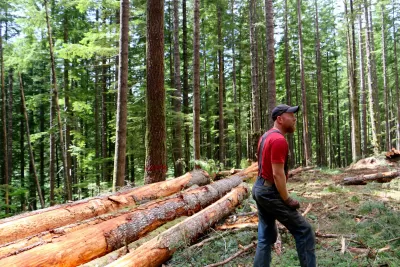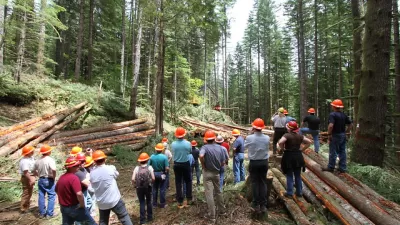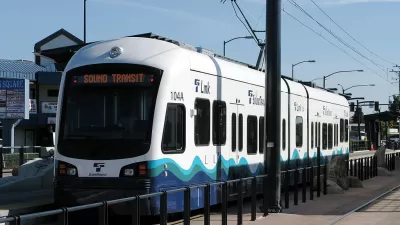Cross-laminated timber offers a multitude of environmental and economic benefits. With the state’s resources and Seattle’s construction needs, the city is the ideal location for mass timber production to take off.

"With vast timber resources and ready for retrofit facilities, the Pacific Northwest has an opportunity to lead a revolution in sustainable building and with the major challenges Seattle is facing around housing affordability and homelessness, our city can and should be at the center of demand for mass timber," writes Conor Bronsdon.
Cross-laminated timber is an ideal alternative to steel and concrete, argues Bronsdon. It performs well as a construction material, can be assembled quickly and easily at construction sites, and requires much less energy for production than steel.
Bronsdon notes that developments at the state and national levels are making cross-laminated timber a more viable option:
The passage of the Timber Innovation Act, officially signed into law in December as part of the national Farm Bill, is a big step for incentivizing the use of CLT. One of the most important provisions of the bill is that it provides annual matching grants to advance innovation in wood construction including prioritizing the use of funds to retrofit sawmills in areas of high unemployment.
He says this is an opportunity to revitalize the flagging economies of rural Washington communities dependent on the timber industry. Washington also last year changed its state building code to allow for mass timber to be used in taller buildings.
Bronsdon says that a partnership between environmental groups and the timber industry would encourage sustainable in-state production. "With responsible and economically incentivized forest management, we can change the calculus of deforestation, encourage replanting and continued harvesting as younger and lower grade trees can be used in mass timber products such as CLT."
FULL STORY: Seattle Should Lead on Mass Timber–and Solve Our Housing Crisis

Study: Maui’s Plan to Convert Vacation Rentals to Long-Term Housing Could Cause Nearly $1 Billion Economic Loss
The plan would reduce visitor accommodation by 25,% resulting in 1,900 jobs lost.

Placekeeping: Setting a New Precedent for City Planners
How a preservation-based approach to redevelopment and urban design can prevent displacement and honor legacy communities.

North Texas Transit Leaders Tout Benefits of TOD for Growing Region
At a summit focused on transit-oriented development, policymakers discussed how North Texas’ expanded light rail system can serve as a tool for economic growth.

Inferior US Vehicle Standard Threaten European Safety
EU vehicles are much safer than U.S. vehicles due to better standards. The U.S. wants its standard to be considered ‘equivalent’ for import purposes. A European Transport Safety Council report examines the conflict.

Washington State Plans Ambitious ‘Cycle Highway’ Network
The state is directing funding to close gaps in its existing bike network and make long-distance trips more accessible.

Homeowners Blame PG&E for Delays in ADU Permits
The utility says it has dramatically reduced its backlog, but applicants say they still face months-long delays for approvals for new electrical work.
Urban Design for Planners 1: Software Tools
This six-course series explores essential urban design concepts using open source software and equips planners with the tools they need to participate fully in the urban design process.
Planning for Universal Design
Learn the tools for implementing Universal Design in planning regulations.
Borough of Carlisle
Caltrans
Heyer Gruel & Associates PA
Institute for Housing and Urban Development Studies (IHS)
City of Grandview
Harvard GSD Executive Education
Salt Lake City
NYU Wagner Graduate School of Public Service
City of Cambridge, Maryland





























